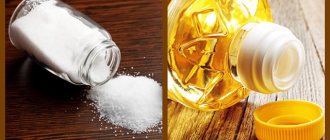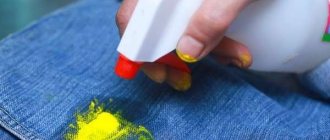Pistol foam TECHNONICOL 50 all-season 650 ml. Photo by Leroy Merlin
Polyurethane foam is used to solve various problems : sealing cracks, waterproofing and other repair and construction work. The demand for foam is promoted by a number of positive characteristics , one of the main ones being high adhesion. In some cases, this property acts as a disadvantage . Since various surfaces and fabrics are often difficult to clean from polyurethane sealant.
To remove foam from clothes, various methods, tools and means (special and improvised) are used, which are presented in the article.
How to clean fabrics at home from fresh mixture
It is much easier to remove fresh mounting foam from fabric than cured polyurethane sealant. Because foam, when it gets on clothes, begins to expand and penetrate deeper into the finest fibers of the fabric. Therefore, it is recommended to take immediate measures to prevent the spread of contamination. To do this, you need to carefully remove the foam mass with a spatula or a coarse clean cloth.
Attention! Foam must be removed from the edges of the dirt towards the center. There is no need to spread the stain around the perimeter, as its area will only increase.
Remaining contamination can be removed using a special gun cleaner . To do this, moisten a cotton or fabric swab in the product and wipe the foam stain. Almost all manufacturers of polyurethane foam also offer cleaners, which are sold in hardware stores in the form of liquid in aerosol cans or in the form of soaked wipes. The range of ]Soudal[/anchor], Penosil, Makroflex, Tytan, TECHNONICOL and many others includes cleaners for fresh and hardened foam. After treatment with a special product, clothes must be washed in a machine or by hand with a large amount of powder, pre-soaking and thorough rinsing.
Foam cleaner Penosil 0.34 l. Photo by Leroy Merlin
Some (especially economical) performers prefer not to buy special products, but to use alternative solutions . In the absence of a cleaner, it is possible to use any solvent, for example, acetone, white spirit, purified gasoline, solvent, nail polish remover, number 647, etc. The more aggressive the product, the more effective its use.
Attention! Aggressive products can discolor, discolor, damage the structure and/or deform many fabrics. Therefore, before using any product, it is necessary to conduct a preliminary test on an inconspicuous place, for example, on the inner lapel.
Prevention
As you know, a problem is easier to prevent than to solve. Therefore, try to protect yourself, your clothes and furniture in your apartment as much as possible when working with foam. What should be done:
- Be sure to wear gloves to prevent the substance from getting on your hands.
- Cover your head with a cap or other head covering. This will protect your hair not only from foam, but also from dust and construction debris.
- Wear old clothes that you can safely get dirty. It should be comfortable and completely cover the body to prevent further rubbing of foam from the skin.
- You can buy special disposable overalls for construction work to protect yourself and your clothes as much as possible. You can also use a disposable raincoat for this purpose.
- When renovating, it doesn’t hurt to always cover floors and pieces of furniture if they have not been removed. To do this, you can use old bedspreads, newspapers or plastic wrap.
- Try to work carefully and do everything according to the instructions.
Using these simple techniques, you can remove foam from jackets, clothes, furniture and other things. And do not forget to test the selected product on the inside of the product before using it, because it is unknown how your fabric will behave in this case.
Share on social media networks:
How can you remove dried foam?
It is not always possible to notice immediately when polyurethane foam gets on clothing . As a result, the mixture hardens. Removing cured polyurethane sealant from clothing is much more difficult, but it is possible. Only this will require slightly different methods and means . First of all, it is necessary to mechanically remove the bulk of the foam ; for this, a blade, knife, spatula or other sharp object is used. Thorough removal of the composition from the fibers is facilitated by the use of a toothbrush or pumice . Residues of hardened polyurethane can be removed using several means, which are discussed in detail below.
Remove using special means
By “special means” we usually mean cleaners or, as they are also called, liquids for washing the mounting gun, liquids for cleaning the mounting gun (the abbreviation JOMP is often found) and spray solvents designed specifically for removing foam. The procedure is as follows:
- soft foam is removed from the fabric using a spatula or a piece of cardboard, the hardened mass is cut off;
- it is necessary to try to remove as much of the mixture as possible, which will facilitate the removal of residues;
- A piece of clean white cloth is moistened in gun cleaning fluid or solvent, and the stain is gently wiped off.
Polyurethane foam cleaner Tytan Prof Eco 0.5 l. Photo by Leroy Merlin
Foam solvent is a more aggressive and, therefore, more effective product than gun cleaning fluids, and therefore is suitable for removing dried contaminants. You must proceed as follows:
- a piece of gauze or a piece of clean cloth is soaked in a solvent;
- the dirt is thoroughly wiped several times; to increase the effect, you can drop the product directly onto the stain and leave for 15-20 minutes;
- then you need to re-wet the dirt with liquid and clean off the remaining polyurethane with a brush or abrasive sponge.
After finishing work with aggressive substances, it is necessary to machine or hand wash the clothes with a significant amount of powder, thoroughly soaking and rinsing.
Axton foam cleaner, 0.5 l. Photo by Leroy Merlin
It must be remembered that the substances included in special products can damage fabric fibers and change the color of clothing. Therefore, before using the product, you need to evaluate its effect by dropping it on a place that is not conspicuous. But at the same time, most often foam ends up on work clothes made from thick cotton-based fabrics. They are distinguished by high resistance to aggressive substances . to use various solvents on work clothes .
Things are much more complicated when working with delicate fabrics. Exposure of fur, suede, silk, wool and other fabrics to solvents will lead to destruction of their structure . In addition, removing contaminants from these materials is a complex process. Therefore, it is strongly recommended to carry out work using polyurethane foam in special clothing, gloves and a respirator, since it is problematic to remove polyurethane from the skin.
Specific options for special means for removing contaminants are:
- Makroflex Premium is a professional cleaner recommended for removing uncured foam from fabrics and surfaces;
- Grover Cleaner and Grover Remover are cleaners of hardened foam from various surfaces: metal, wood, PVC, textiles, leather.
Dimexide to remove hardened mixture, then wash
Surprisingly, to remove polyurethane foam from various surfaces, including clothing, a common external medicine is used , intended for the treatment of injuries and diseases of the joints. Dimexide can be purchased at a pharmacy. It is first necessary to carry out standard work, i.e. perform mechanical cleaning, cutting off a significant mass of hardened polyurethane.
Then you need to apply Dimexide to the stain and the area around it in any convenient way: carefully pour it out of the bottle, soak a cotton swab or cloth and apply it to the stain. To prevent evaporation of the solution, it is recommended to cover the area to be treated with cling film . Leave for 30-40 minutes. The remaining foam is removed with a brush or sponge with an abrasive surface . After finishing cleaning, clothes should be washed by hand in a machine, rinsed thoroughly in plenty of water in accordance with the recommendations on the label.
Clean with gasoline and other chemicals
To remove old dirt, it is possible to use chemicals. To help get rid of foam:
1) Gasoline. It is important to remember that you must use refined gasoline, which is sold as lighter fuel. The algorithm of actions is as follows:
- the maximum amount of frozen mass is removed mechanically;
- a white cotton cloth is soaked in gasoline and applied to the area of contamination, left for 20 minutes;
- the cloth is removed, the treated area is washed with warm water and laundry soap;
- The item is completely washable in a machine or by hand; it is also recommended to use conditioner and additionally rinse the clothes thoroughly.
Attention! It is recommended to dry clothes in the open air, as the smell of gasoline will disappear faster.
As an alternative to purified gasoline, kerosene and stain remover , which can be used as any available product sold in a supermarket or household chemical stores, for example, Vanish . You need to do the following:
- after removing the main fragments of the frozen mass, the area of contamination is wiped with kerosene;
- you need to wait 30 minutes and slightly moisten the stain, apply stain remover and carefully wash;
- After 30 minutes, you need to wash the clothes in the machine.
2) Acetone is a powerful solvent that can destroy polymer compounds in a short time. Acetone is applied to the stain using a cotton pad and left for 15-30 minutes. The softened foam is rubbed off with a thick cloth or a brush with soft bristles.
White spirit 1 l. Photo by Leroy Merlin
3) White spirit is used in the same way as acetone.
Important! The use of chemicals requires compliance with safety precautions. It is necessary to carry out work in a well-ventilated area or outdoors; the use of gloves and a protective mask is required.
4) Alcohol is a popular household solvent that can be used to clean light-colored and colored clothing . Alcohol can be classified as both a chemical cleaning agent and an improvised one; we’ll look at it here. Alcohol is quite gentle on fabrics and allows you to remove fresh and old stains from foam. It is possible to use several types : medical and ammonia, vodka. Regardless of the selected type, you must perform the following steps:
- pour alcohol or vodka into a small container;
- place the contaminated area in the liquid;
- leave the clothes in the solvent for 40-60 minutes;
- remove the remaining frozen foam with a brush;
- wash clothes.
Attention! Using ammonia requires finishing the wash with the addition of a fragrant conditioner, which will help remove the smell of ammonia.
Folk remedies
It is also possible to remove hardened polyurethane using improvised means, so-called folk methods . These methods allow you to save money on the purchase of special, chemical or pharmacological agents. But you will have to spend more time and effort.
1) Vegetable oil. Sunflower or any other vegetable oil can be used to dissolve paint, varnish and foam. The oil is suitable for removing fresh and hardened stains. It is one of the safest methods. It is possible to use several technologies using oil ; the contractor will need additional funds.
Systec knife 25 mm, two-component handle. Photo by Leroy Merlin
1.1) The oil is heated until hot. The maximum amount of foam is cut off with a knife. Oil is poured onto the contaminated area. The stain is washed off in hot water using dish gel, which will help remove oil traces. This method is not suitable for fabrics that cannot be washed at high temperatures, i.e. for synthetics and natural delicate fabrics.
1.2) The main part of the hardened sealant is cut off. Vegetable oil is applied to the stain , left for 10-15 minutes, sprinkled with washing powder , left for another 10 minutes. The dirt must be rubbed off with your hands or a brush, and the clothes must be washed in the standard manner.
Reference. The safety of the hand-made products used allows you to reapply vegetable oil to the stain if it was not possible to remove the stain the first time.
2) Table salt. In some cases, soaking clothes in a salt solution helps to remove stains. To do this, you need to prepare a solution at the rate of five tablespoons of salt per liter of hot water. Place clothes in the resulting solution for 30-60 minutes. Wipe off the softened foam with a brush.
3) Soap solution and soda. It is necessary to prepare a solution from the following components : half a glass of soap shavings (laundry soap is recommended), one glass of hot water, 3 tablespoons of soda. Mix all ingredients. the resulting mixture to the stain and scrub with a clothes brush. Leave for 20-30 minutes and rub again. Finally, soak the clothes for 1-2 hours in the remaining soap-soda solution with added water. Then wash by hand or in a machine with an additional rinse.
4) Soda and citric acid. Soda and citric acid are mixed in a ratio of 2 to 1. The mixture is poured onto the stain, and a small amount of dishwashing detergent is added. The quenching reaction will begin and the composition will foam. The resulting bubbles remove foam particles from the fabric fibers. If necessary, repeat the steps 2-3 times.
Remove using glue softeners
On sale it is possible to find special compositions designed to soften glue and other tenacious products . They are quite effective in combating contamination from polyurethane foam. Among the well-proven products, Secunda anti-glue especially stands out . Products of various brands are provided to customers : Moment, Force, Contact and others. In general, there is enough choice.
Anti-glue Super Moment, 5 g. Photo by Leroy Merlin
Anti-glue must be applied to the hardened foam and left for 15-30 minutes , preventing it from drying out again. Afterwards, the foam must be removed with a brush, sponge or a mild knife. To remove marks, clothes can be wiped with a cotton pad soaked in anti-glue. The product is available in the form of a gel and spray.
Remove using physical methods
1) Exposure to low temperatures, freezing is a somewhat exotic method. It is distinguished by its high efficiency, which has been repeatedly tested by experienced housewives when removing chewing gum. Contamination can be removed by following the following sequence of actions:
- contaminated clothing is placed in a plastic bag or a special zip-lock bag or carefully wrapped in film so that the problem area is outside;
- the package is placed in the freezer;
- you must wait, the recommended waiting time is at least 3 hours;
Reference. Temperatures below -20 degrees Celsius make the cured polyurethane composition brittle.
- remove foam manually by rubbing the area of contamination, with a non-sharp knife, clothes brush, pumice stone or other mechanical method;
- if there is a small amount of foam left in the fibers, you can get rid of it with sandpaper or a nail file; wash clothes.
Final cleaning can be done mechanically or using folk remedies.
2) Ultraviolet/direct sunlight . Any polyurethane foam dries out and is destroyed when exposed to ultraviolet radiation, so the seams must be protected. This characteristic can be used to salvage clothing. Removing contaminants is very simple . To do this, you need to place the item in such a way that direct sunlight hits the dirt.
However, this method has several disadvantages. First, it will take several days for the stain to remove. Also, once a day you need to approach the item and clean the surface, removing the destroyed foam. Secondly, the method is not suitable for colored fabrics that fade in the sun. Thirdly, the method does not guarantee 100% results. As a result, upon completion of the work, it will be necessary to treat the contamination in another way, most often using chemicals.
Physical methods
Physical methods for removing traces of polyurethane foam are safe for fabric. Two methods can be used:
- Freezing. Place the affected clothing in a plastic bag and place it in the freezer for several hours. You need to make sure that the stained area remains on top. After freezing, the foam becomes more brittle; it is cleaned mechanically.
- Ultraviolet. The sun's rays destroy the polyurethane foam, however, destruction will take a lot of time. The method is simple. The clothes are laid out so that the soiled area receives direct sunlight. You will have to keep your clothes in this place for several days. Once a day you will need to approach the item and clean the surface, removing destroyed particles of foam. The method is not suitable for colored fabrics that may fade in the sun.
However, physical methods rarely help to completely get rid of traces of foam on clothing. Usually, after their use, it is necessary to additionally use chemical cleaning methods.
What can and cannot be washed from jackets, pants, jeans and other things, shoes
To remove dirt from various items of clothing and shoes, you cannot use some familiar means:
Soudal foam cleaner 0.1 l. Photo by Leroy Merlin
1) Water. They first try to remove any dirt with water. But in this case, doing this is strictly prohibited. Polyurethane foam has a porous structure and absorbs water, thereby penetrating even deeper into the fibers of the fabric. In addition, water helps the mixture harden.
2) High temperatures. Heating leads to a change in the structure of the tissue, but is not sufficient to remove contamination mechanically. When cooling, the components of the composition penetrate even deeper into the fibers of the fabric, which makes it difficult to get rid of dirt.
3) Unrefined gasoline. The composition of the unrefined fuel is not aggressive enough to destroy the polymer bonds of the foam. But stains from using gasoline are almost impossible to remove.
4) Vinegar essence is used to remove stains from various surfaces. However, some experts do not recommend its use, since it is unable to dissolve contamination. In addition, when removing stains from clothes, the essence will ruin the fabric.
5) Hydrogen peroxide solution . Peroxide reacts with foam components, making the composition more viscous. As a result, the mixture adheres even more to the fibers of the fabric.
Why is it so hard to scrub off?
Polyurethane foam TYTAN LEXY 20 300 ml. Photo by Maxidom
Foam is a polyurethane sealant that contains a significant amount of chemicals: stabilizers, catalysts, thickeners, isomers. As a result, foam is difficult to remove from clothes and shoes (and other surfaces as well) for several reasons:
- Expansion of the mixture. When the composition leaves the aerosol can, the foam begins to actively expand due to the presence of gas in the composition. Once on clothing, the foam continues to expand for some time, simultaneously penetrating the fabric structure. Even low expansion foams are difficult to remove from fabric.
- Fast curing. Quick drying, which takes an average of 15-30 minutes, makes it much more difficult to remove contaminants.
- Tissue damage. Removing the stain is not the only task. It is also necessary to avoid damage to the fabric fibers, deformation of the item, and changes in the color of the clothing. But this is not always possible to achieve. Therefore, you need to know the recommendations that will help you avoid getting foam on your hands and clothes.
How to Avoid Getting Hit
- to work with polyurethane foam, you must wear clothes that do not have to be washed; if the owner of a house or cottage regularly needs to carry out repair and construction work independently, then it is recommended to purchase work clothes;
- work must be performed using personal protective equipment: glasses, gloves, hat;
- to protect clothes from contamination, a polyethylene cape/cover or cover for clothes, in which the sleeves must first be cut, is suitable; an alternative is a rough apron;
- It is necessary to monitor the condition and location of the cylinder with the nozzle, since cases of uncontrolled foam coming out of a damaged instrument are quite common.
What to consider when cleaning foam from clothing
The stronger the fabric, the greater the solvent resistance. Cotton shirts, preferred for construction work, are woven using this principle.
If this is the case with more delicate items of clothing (made from fur, nylon, suede and silk), then regular laundry detergent is no longer useful.
“Rubber” destroys dyes, and tearing off entire pieces means completely tearing the outfit - so it’s better to take it to the dry cleaner.
Rules and recommendations for washing off the mixture
1) Wearing special clothing while performing work will allow you not to worry about the presence of contamination and will ensure the ability to use any method of getting rid of stains. Since work clothes made of thick cotton-based fabrics successfully withstand the most aggressive agents.
Respirator Source FFP1 with valve. Photo by Leroy Merlin
2) Do not wash soiled clothes and/or leave them in water for a long time . Exposure to water helps the mixture harden and penetrate even deeper into the fabric fibers.
3) Before cleaning, you need to read the recommendations on the label of the item , paying attention to the composition and type, which will also make it easier to choose a method for removing foam.
4) Working with solvents should be done with thick rubber gloves and a mask.
5) If working with solvents is carried out indoors, it is necessary to ensure maximum air circulation in the room.
6) To avoid damaging the fabric, you must first test the product in an inconspicuous area.
7) Avoid contact of chemicals, solvents and cleaners with skin and mucous membranes.
The stain retains its own size if you remove it from the edges to the center.










